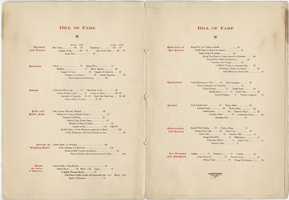Search the Special Collections and Archives Portal
Search Results

Diane Meireis oral history interview: transcript
Date
Archival Collection
Description
Oral history interview with Diane Meireis conducted by Claytee D. White on November 06, 2017 for the Remembering 1 October Oral History Project. In this interview, Meireis discusses her experience at the 1 October shooting. She remembers hearing gunfire, the confusion in the crowd, and finding a safe place to hide. Meireis describes the collaboration of strangers, and feeling guilt for not being able to help others as she escaped the venue. Lastly, Meireis discusses her opinions of firearms.
Text
Ken Hanlon Jazz Music Manuscripts
Identifier
Abstract
The Ken Hanlon Jazz Music Manuscripts (approximately 1975-1990) is comprised of jazz music compositions that were gathered by the Arnold Shaw Popular Music Research Center at the University of Nevada, Las Vegas (UNLV) in Las Vegas, Nevada. The collection includes several scores and arrangements from Hanlon's ensembles, including the UNLV Jazz Band, Seventy-Six Trombones Ensemble, and the Si Zentner Ensemble.
Archival Collection
Rodney Sumpter Papers on Doe v. Bryan
Identifier
Abstract
The Rodney Sumpter Papers on Doe v. Bryan contain the legal files of the lawyer Rodney Sumpter, who represented the appellants in the Nevada District Court case Doe v. Bryan (1985) and subsequent appeal in the Nevada State Supreme Court in 1986. Doe v. Bryan challenged one of Nevada's sodomy laws (NRS 201.190), and the collection contains affidavits, motion requests, correspondence, newspaper clippings, and memoranda regarding the case.
Archival Collection
Perry Kaufman Papers
Identifier
Abstract
The Perry Kaufman Papers (1930-1974) are comprised of research material gathered by Kaufman for his doctoral dissertation, "The Best City of Them All: A History of Las Vegas, 1930-1960." Kaufman's research focused on the Las Vegas, Nevada Chamber of Commerce's role in promoting Las Vegas as a tourist destination. The collection primarily consists of newspaper clippings from the
Archival Collection
Beda and C. Norman Cornwall Photograph Collection
Identifier
Abstract
The Beda and C. Norman Cornwall Photograph Collection (1940s-1978) primarily contains black-and-white photographic prints of Beda and C. Norman engaging in various civic activities. The collection also includes photographic prints of Beda Cornwall’s reception at the University of Nevada, Las Vegas, as well as C. Norman Cornwall’s riding group, the Los Rancheros Visitadores, during their trek through the Santa Ynez Valley in California. Beda Cornwall was the president of the Citizens’ Library Association of Las Vegas and C. Norman Cornwall was a prominent Las Vegas attorney.
Archival Collection
Florence McClure Photograph Collection
Identifier
Abstract
The Florence McClure Photograph Collection (approximately 1985-1997) consists of color photographic prints. Images show McClure and members of the Las Vegas, Nevada Community Action Against Rape (CAAR) organization that she co-founded with Sandi Petta in 1973. Also included are images of Nevada public figures and several travel images from China.
Archival Collection
W. I. Booth and A. Allen Photograph Album of Goldfield, Nevada
Identifier
Abstract
The W. I. Booth and A. Allen Photograph Album of Goldfield, Nevada (approx. 1900-1910) contains forty-five black-and-white photographs taken by photographers W. I. Booth and A. Allen. The images depict the Goldfield, Nevada townsite; mines, miners, camps, and equipment; horses pulling freight and carriages across the desert; and topographical features of Goldfield and outlying areas. The photographs document the mining boom in the Goldfield area during the early 20th century.
Archival Collection
Cliff Olsen Professional Papers
Identifier
Abstract
The collection, 1949 to 2006, was compiled by Clifford Olsen, a containment physicist at the Nevada Test Site (NTS). It consists of research notes and working papers written by Olsen and other scientists, publications, epoxy aggregate samples, work-related correspondence, nuclear-test-event data, and interviews conducted by Olsen with work colleagues involved with the NTS.
Archival Collection
Desert Fishes Council Records
Identifier
Abstract
The Desert Fishes Council Records (1969-1988) consist of resolutions, meeting minutes, symposium programs, agendas, and press releases of the Desert Fishes Council (DFC). The organization is devoted to the study and preservation of Southwestern desert fishes, notably the desert pupfish. The DFC records reflect efforts to bring the plight of desert fishes to the attention of academics and the public as well as highlight the worth of desert lands within the American environmental movement.
Archival Collection

